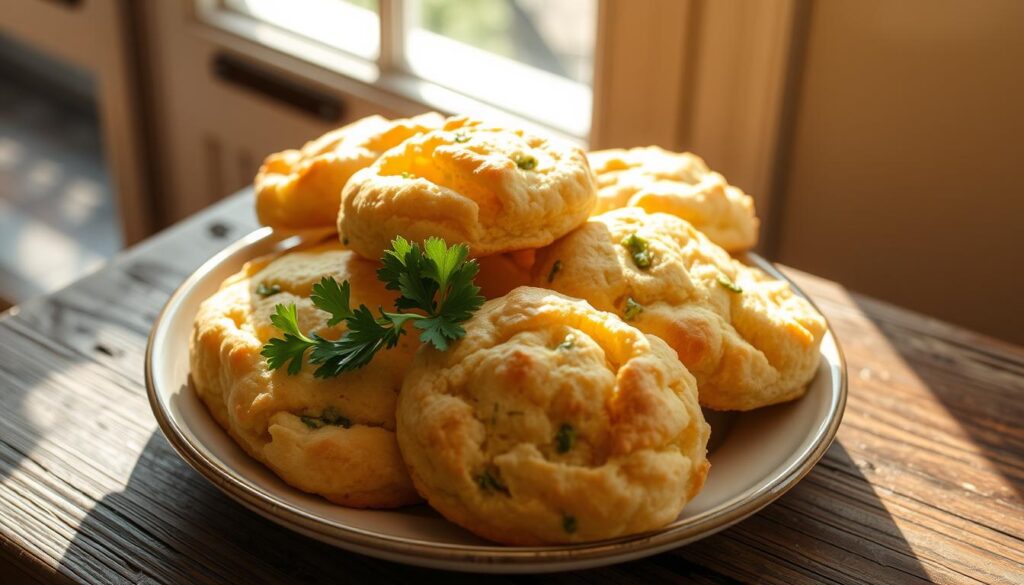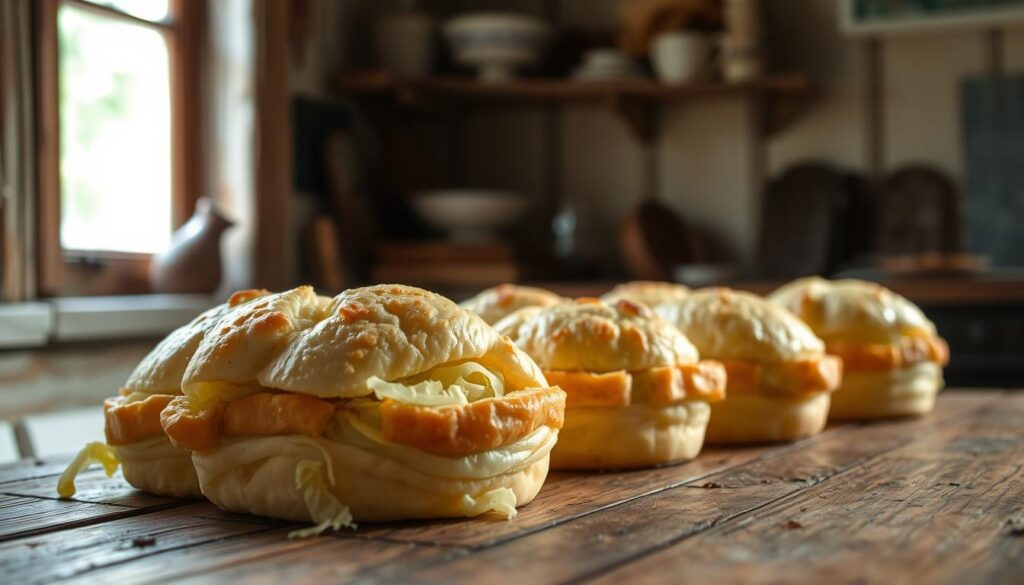We’re excited to share our comprehensive guide to making traditional cabbage biscuits, a savory delight that has been a staple in many family kitchens for generations.
With a prep time of just 20 minutes and a cook time of 40 minutes, you can create 24 delicious cabbage pockets that are perfect for any meal. Our tested recipe includes detailed nutrition information and time-saving tips to help you incorporate these tasty treats into your meal rotation.
At Historical Foods, our mission is to empower home cooks with thorough testing, detailed explanations, and a scientific understanding of cooking. Join us as we explore the history and preparation of this classic dish, and discover how simple ingredients can come together to create something truly special.
The Humble Cabbage Biscuit: A Savory Delight
The simple yet satisfying cabbage biscuit has captured the hearts of food enthusiasts across generations. We appreciate these savory treats for their perfect blend of flavors and textures, making them a staple in many cuisines.
What Are Cabbage Biscuits?
Cabbage biscuits are savory hand-held pastries consisting of a flavorful filling of ground beef and cabbage enclosed in a soft yet sturdy dough exterior. The filling typically features cabbage as the star ingredient, complemented by meat and aromatics.

Why They’ve Remained a Beloved Dish
These versatile treats have remained popular through generations because they’re portable, freezable, and adaptable to various taste preferences and available ingredients. Many families have their own variations of this recipe, reflecting regional and personal preferences.
| Characteristics | Benefits | Features |
|---|---|---|
| Savory Filling | Provides a self-contained meal | Ground beef and cabbage |
| Soft yet Sturdy Dough | Easy to handle and store | Perfect for on-the-go |
| Versatile | Adaptable to various tastes | Can be frozen for later use |
The History Behind Cabbage Biscuits
As we explore the history behind cabbage biscuits, we uncover a tale of cultural exchange and adaptation. Cabbage biscuits have their roots in Eastern European cuisine, where cabbage was a staple due to its affordability and nutritional value.

Origins and Cultural Significance
Cabbage biscuits originated as a practical solution for agricultural workers needing portable meals. The combination of cabbage and dough is seen in various cultures, from Russian pirozhki to Polish bierock. These dishes reflect the resourcefulness of cooks who utilized locally available ingredients to create nourishing meals.
- The use of cabbage and dough represents a common culinary thread across cultures.
- These savory pockets were designed to be filling and easy to consume on the go.
How the Recipe Evolved Over Time
As immigrants brought their recipes to America, they adapted to local tastes and cooking methods. The core elements of cabbage, onions, and a simple dough wrapper remained consistent, speaking to the timeless appeal of this humble dish. Modern adaptations, such as using frozen dinner rolls, have made this traditional dish more accessible.
- The evolution of cabbage biscuits demonstrates the dynamic nature of culinary traditions.
- Despite changes, the essence of the recipe has remained intact.
Essential Ingredients for Perfect Cabbage Biscuits
Crafting the perfect cabbage biscuits requires a thoughtful selection of ingredients. The quality of these components directly impacts the flavor and texture of the final product.
The Filling Components
The filling is the heart of the cabbage biscuit, providing its distinctive flavor profile. We recommend using 1 pound of ground beef with a moderate fat content (80/20 is ideal) paired with one whole head of cabbage, shredded or finely chopped.
Ground Beef and Cabbage Base
The combination of ground beef and cabbage creates a savory and satisfying filling. For the best results, use fresh, high-quality ingredients.
Aromatics and Seasonings
Aromatics like onions and garlic play a crucial role in elevating the flavor. Season with salt and pepper to taste, and consider adding other spices for complexity.
Dough Options
For the dough, you can either use a 2-pound package of frozen dinner rolls for convenience or make dough from scratch for a more personalized texture and flavor.
Using Frozen Dinner Rolls
Frozen dinner rolls offer a convenient and time-saving option. Simply thaw according to the package instructions.
Making Dough From Scratch
Creating dough from scratch allows for customization. Basic ingredients include flour, water, yeast, salt, and often butter or oil to enrich the texture.
Step-by-Step Cabbage Biscuits Recipe
With our expert tips and a simple step-by-step approach, you’ll be enjoying homemade cabbage biscuits in no time. This recipe is designed to guide you through the process with ease, ensuring that your cabbage biscuits turn out perfectly every time.
Preparing the Filling
The filling is a crucial component of cabbage biscuits. To prepare it, start by cooking the meat and vegetables. Heat a large skillet over medium-high heat and cook the ground beef until it’s browned and crumbly, breaking it apart as it cooks. This should take about 5 to 7 minutes. Then, add chopped onions and sauté until they’re translucent, which takes around 5 minutes. Finally, add shredded cabbage and cook until it has wilted slightly, about 5 minutes more. Season with salt and pepper to taste.
Cooking the Meat and Vegetables
Cooking the ground beef and vegetables is a critical step. Ensure the beef is fully browned and the onions are soft and translucent.
Draining and Cooling
After cooking, drain the excess liquid from the mixture and let it cool slightly. This step is essential to prevent soggy biscuits.
Working with the Dough
Once your filling is ready, it’s time to work with the dough. Roll out the dough into discs, about 4-5 inches in diameter. Place 1-2 tablespoons of the cooled filling in the center of each disc. Be careful not to overfill, as this can make sealing difficult.
Rolling and Filling Techniques
Use a rolling pin to flatten the dough into discs. Spoon the filling onto the center, leaving enough room around the edges to seal the biscuit.
Sealing Methods
Fold the dough over the filling to create a half-moon shape and press the edges together firmly to seal. You can use your fingers or the tines of a fork to ensure a secure seal.
Baking Instructions
Preheat your oven to 350°F (175°C). Place the sealed biscuits on a baking sheet lined with parchment paper or in muffin cups. Poke each biscuit with a toothpick to allow steam to escape. Bake for 25-45 minutes, or until the dough is golden brown and cooked through.
Temperature and Timing
Bake the biscuits at 350°F (175°C) for 25-45 minutes, depending on their size and the type of dough used.
How to Tell When They’re Done
The biscuits are done when they’re golden brown on the surface and the dough is completely cooked through. Check by gently lifting one biscuit; if it’s still pale or doughy, continue baking in short intervals until done.
Tips and Variations for Your Cabbage Biscuits
To take your cabbage biscuits to the next level, consider exploring various flavor enhancements and serving suggestions. We can elevate this traditional recipe by introducing new ingredients and creative serving ideas.
Flavor Enhancements
For a more complex flavor profile, we can add aromatic spices and fresh herbs to the filling mixture. This not only enhances the taste but also increases the nutritional value.
Adding Extra Spices and Herbs
Consider adding caraway seeds, paprika, or a pinch of nutmeg to give your cabbage biscuits a unique twist. Fresh herbs like dill or parsley can be added towards the end of the cooking process to preserve their flavor and nutritional benefits.
Using Leftover Meats
Don’t limit yourself to ground beef; you can use leftover pot roast, brisket, or even roasted chicken as a substitute. This adds depth of flavor and is a great way to repurpose leftovers.
Serving Suggestions
The right accompaniments can elevate your cabbage biscuits experience. Consider serving them with a crisp green salad or a side of pickled vegetables.
Complementary Sides
A simple side salad or a clear soup can complement the richness of the biscuits. For added flavor, try serving with yellow mustard or a yogurt-dill sauce.
Storage and Reheating
Cabbage biscuits can be frozen before or after baking. To reheat, wrap them loosely in foil and warm in a 325°F oven for about 15 minutes. Alternatively, use a microwave at 50% power with a damp paper towel to maintain moisture.
Conclusion: Why Cabbage Biscuits Deserve a Place in Your Recipe Collection
In wrapping up our exploration of cabbage biscuits, we find that their appeal lies in their simplicity, nutritional value, and the memories they help create. These versatile pockets offer a perfect balance of nutrition and satisfaction, providing protein, vegetables, and carbohydrates in a single, portable package.
The humble ingredients required—cabbage, ground meat, and basic pantry staples for the dough—make this an economical choice that delivers remarkable flavor. By mastering the basic technique, you can customize the ingredients and seasonings to suit your family’s preferences. Whether you’re drawn to these biscuits for their practicality or flavor, they’re sure to become a staple in your kitchen.


